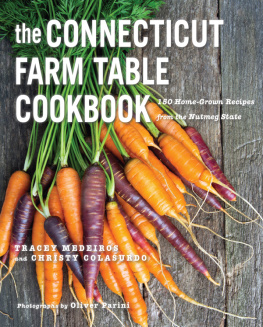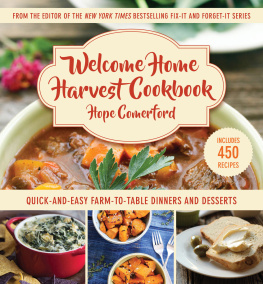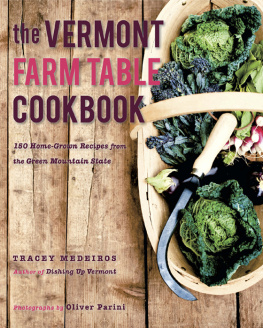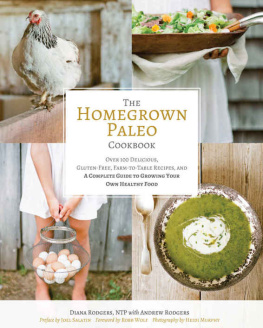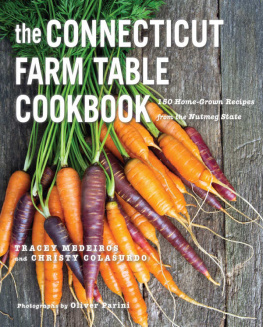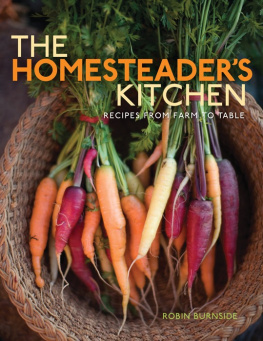
the
CONNECTICUT
FARM TABLE
COOKBOOK
100 Home-Grown Recipes
from the Nutmeg State
TRACEY MEDEIROS
AND CHRISTY COLASURDO
Photographs by Oliver Parini



Waldingfield Farm
We dedicate this book to the Connecticut farmers, fishermen, cheese makers, beekeepers, foragers, and food producers who take great painsand pridein bringing us fresh, wholesome local foods, while serving as responsible stewards of our natural resources. Neither drought, nor rain, nor heat, nor pests can keep these hardy souls from their appointed rounds.
We salute you for your commitment to providing us with a colorful array of locally grown edibles that nourish our health, our ecosystem, and our communities. We are enduringly grateful.

Matt and Jess at Speckled Rooster Farm

Chef/restaurateur Bill Taibe at Farahs Farm
FOREWORD
The Connecticut Farm Table Cookbook beautifully captures the profound shift in tastes and attitudes that have transformed the Connecticut restaurant scene into one with a purpose beyond pleasing our palates. Chefs were the first to champion the work of our farmers and artisan food producers, enticing us with fresh, seasonal foods enhanced by culinary alchemy into meals so deliciously memorable we had to tell all our friends about them and couldnt wait to return for another visit. Word spread, more eaters came, and ever-increasing numbers of chefs were inspired to source vegetables, fruit, meat and poultry, cheese, bread, honey, maple syrup, and even wine and spirits from small Connecticut farms and producers. In less than a decade, the most exciting and delicious food in Connecticut is now crafted with ingredients grown and raised close to home.
Eaters were so strongly influenced by such pioneering chefs as Michel Nischan, Bill Taibe, and Tim LaBant, that we began frequenting farmers markets and buying into community supported agriculture (CSA) programs in pursuit of sustainably grown, local flavors for our own tables. Demand for food grown by our farmers and artisans has become so regular that Fairfield County alone boasts seven winter farmers markets and more than 30 spring/summer farmers markets. From springs first asparagus to frost-sweetened parsnips in winter, our farms provide us with sustenance throughout all four seasons. Consumers who find farmers market schedules inconvenient rely on farm-to-door delivery services to stock their refrigerators and pantries. One does not have to travel far, or at all, to find green garlic in the spring, sweet corn in the summer, freshly dug potatoes in the fall, and celeriac in the winter.
The Connecticut Farm Table Cookbook pays homage to the passionate work of our chefs, farmers, and artisan food producers while providing home cooks with the gift of re-creating favorite restaurant meals at home. Simplicity is the hallmark of the recipes found in this cookbook, ensuring at least a handful will become regulars in weeknight dinner rotations. Restaurant, chef, farmer, and artisan food producer profiles take readers on a journey of food discovery through Connecticut, while spotlighting annual events to bookmark as road trips and farm dinners with celebrated chefs to plan with friends. Touring farms, visiting wineries for tastings, picking your own fruit in orchards, learning how farmstead cheese is made and aged, and tasting honey straight from the hive are powerful catalysts for changing the way we think about food. Taste trumps all and is therefore the ultimate arbiter in our decision to adopt the philosophy of eating locally and sustainably.
The local food web is incomplete without eaters like you and me who have come to appreciate the impact our food choices have on our health, our community, and the environment. Enjoy this cookbook as you lovingly prepare and share restaurant-quality meals with friends and family that reflect the Connecticut seasons, connect us to the land, and strengthen our communities.
Every meal crafted from locally grown and raised ingredients is an investment in a more sustainable future.
Analiese Paik
Local-sustainable food advocate and founder of the Fairfield Green Food Guide

Sub Edge Farm
Contents
Please bookmark your page before following links.

Barcelona Wine Bar and Restaurant

Baileys Backyard
March Farm is a fourth-generation family farm set on 150 acres in northwest Connecticut. In addition to operating the areas most popular pick-your-own (PYO) fruit and berry operation, the March family has created a thriving agritourism destination. Ben March says, We understand the importance of keeping people connected with where their food comes from and strive to create a hands-on farm experience for all ages. We offer many PYO crops (strawberries, blueberries, cherries, peaches, apples, and pumpkins), seasonal activities, such as corn mazes and hayrides, as well as a free playscape and animal yard.
The year-round parade of visitors comes for more than apples, fruit pies, and cider donuts. They travel to Bethlehem to experience the tranquil beauty of the Litchfield County farm and to interact with the March family, which has worked this land for more than 100 years.
Purchased in 1915 by Thomas and Rose Marchukaitis, the farm originally consisted of 114 acres with 15 cows and two horses. In 1937, Thomas and Roses son, Matthew, and his wife, Anastasia, bought the farm; they operated it for many years. In 1976, the farm was purchased by Matt and Anastasias son, Tom, and his wife, Sue, who continue to run it with the help of their son, Ben, and Sues brother and nephew.
During the 1940s, the family added 50 cows and about 600 chickens. In the 1950s, they purchased 14 acres of adjoining land and planted apples, which would become a star attraction. Over the next three decades, the farm grew to 100 dairy cattle, 40 acres of fruit trees, 5 acres of blueberries, and many acres of sweet corn, cabbage, potatoes, squash, pumpkins, other vegetables, and hay.
The March family also helped launch the Litchfield Hills Farm-Fresh Market held on Saturday mornings. Recently, the farm was celebrated in March Farm: Season by Season on a Connecticut Family Farm , a pictorial homage authored by Bethlehem resident Nancy McMillan.

Next page
